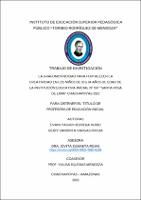| dc.contributor.advisor | Dra: Zumaeta Rojas, Jovita | es_PE |
| dc.contributor.author | Herrera Rubio, Evani Yasuri | es_PE |
| dc.contributor.author | Vargas Rocha, Geidy Sandrita | es_PE |
| dc.contributor.editor | Herrera Rubio, Evani Yasuri | es_PE |
| dc.contributor.editor | Vargas Rocha, Geidy Sandrita | es_PE |
| dc.date.accessioned | 2025-06-24T21:08:38Z | |
| dc.date.available | 2025-06-24T21:08:38Z | |
| dc.date.issued | 2023-12-28 | |
| dc.identifier.uri | http://hdl.handle.net/123456789/26 | |
| dc.description.abstract | The present research work named the graphomotor skills to strengthen the
creativity on 3 and 4 year-old-children from the kindergarten “Santa Rosa de Lima”
has as a general objective, to prove the influence of graphomotor skills workshop to
the strengthening creativity; therefore, it was made a kind of investigation taken within
of a qualitative approach, with an applied research level and a pre-experimental design
with a single group, and with an entry and exit test, having the rubric of evaluation in
order to get the statistic results, having the variables of graphomotor skills and
creativity with the fluency, flexibility, originality and elaboration dimensions, which
it was worked with a population of 35 and a sample of 14 year-old-children, the results
obtained were 5 children at the achieved level and 9 children at the level achieved
outstanding, concluding that graphomotor skills significantly influence the
strengthening of creativity, improving skills and abilities, allowing the development
of imagination.
Keywords: Graphomotor skills, strengthening creativity, development of
imagination. | es_PE |
| dc.description.tableofcontents | RESUMEN..................................................................................................................iii
ABSTRACT................................................................................................................iv
DEDICATORIA .......................................................................................................... v
AGRADECIMIENTO ................................................................................................ vi
INTRODUCCIÓN ....................................................................................................... 1
CAPITULO I................................................................................................................ 2
PROBLEMA DE INVESTIGACIÓN.......................................................................... 2
1. PROBLEMA DE INVESTIGACIÓN .............................................................. 2
1.1 Planteamiento del problema............................................................................ 2
1.2. Formulación del problema............................................................................. 4
1.3. Objetivos de la investigación..................................................................... 5
1.4. Formulación de hipótesis............................................................................... 6
1.5. Justificación de la investigación .................................................................... 7
CAPITULO II
MARCO TEÓRICO.............................................................................................. 9
2. MARCO TEÓRICO.......................................................................................... 9
2.1. Antecedentes de la investigación................................................................... 9
2.2. Bases teóricas............................................................................................... 13
2.3. Definición de términos básicos.................................................................... 23
CAPITULO III
METODOLOGÍA............................................................................................... 25
3. METODOLOGÍA Y ESTRATEGIAS DE INVESTIGACIÓN..................... 26
3.1. Identificación de las variables de la investigación................................... 26
3.2. Tipo, nivel y diseño de investigación .......................................................... 28
3.3. Población y muestra..................................................................................... 29
3.4. Técnicas e instrumentos de recolección de datos ........................................ 30
3.5. Proceso de pruebas de hipótesis y análisis de datos .................................... 32
4. DESCRIPCIÓN DE RESULTADOS ............................................................. 35
4.1. Resultados: Figuras y tablas estadísticas (referidos a los objetivos y/o
hipótesis)............................................................................................................. 35
CAPITULO V
DISCUSIÓN, CONCLUSIONES Y SUGERENCIAS ...................................... 46
5. DISCUSIÓN, CONCLUSIÓN Y RECOMENDACIONES........................... 47
Discusión de resultados.............................................................................................. 47
CONCLUSIONES ..................................................................................................... 50
RECOMENDACIONES............................................................................................ 51
Referencias bibliográficas.......................................................................................... 52
ÍNDICE DE TABLAS
Tabla 1: Frecuencia estadística sobre las medidas de posición de tendencia central 35
Tabla 2: Tabla de Frecuencia resultantes de la evaluación de entrada en torno a la
creatividad.................................................................................................. 35
Tabla 3: Total, agrupado de la creatividad................................................................. 36
Tabla 4: Total (agrupado) del nivel de creatividad en la dimensión Fluidez............. 37
Tabla 5: Total (agrupado) del nivel de creatividad en la segunda dimensión
Flexibilidad.................................................................................................... 38
Tabla 6: Total (agrupado) del nivel de creatividad en la tercera dimensión
Originalidad............................................................................................... 39
Tabla 7: Total (agrupado) del nivel de creatividad en la cuarta dimensión
Elaboración. ................................................................................................... 41
Tabla 8: Frecuencia estadística de las medidas de tendencia central con el propósito
de potenciar el lado creativo en infantes con 3 y 4 años, de la I.E. N° 047
¨Santa Rosa de lima¨ de Chachapoyas 2023 .............................................. 42
Tabla 9: Tabla de Frecuencia obtenidos del post test para fortalecer la creatividad...42
Tabla 10: Total, agrupado de la creatividad................................................................ 43
Tabla 11: Total agrupado del nivel creatividad en evaluación de entrada y salida…..44
ÍNDICE DE FIGURAS
Figura 1: Total (agrupado) del nivel de la creatividad del pre test. .......................... 36
Figura 2: Total, agrupado del Pre test y post tes del nivel de creatividad en la
dimensión Fluidez. ................................................................................... 38
Figura 3: Total, agrupado de evaluación de entrada y salida del nivel de creatividad
.................................................................................................................. 39
Figura 4: Total, agrupado de la evaluación de entrada y de salida del nivel creativo
en: dimensión Originalidad...................................................................... 40
Figura 5: Total, agrupado de la evaluación de entrada y de salida del nivel de
creatividad: Dimensión Elaboración....................................................... 41
Figura 6: Total (agrupado) del nivel creativo de la evaluación de salida. ................ 43
Figura 7: Total (agrupado) del nivel de la creatividad de la evaluación de salida. .. 45 | es_PE |
| dc.format | application/pdf | es_PE |
| dc.language.iso | spa | es_PE |
| dc.relation | LA GRAFOMOTRICIDAD PARA FORTALECER LA CREATIVIDAD EN LOS NIÑOS DE 03 y 04 AÑOS DE EDAD DE LA INSTITUCIÓN EDUCATIVA INICIAL N° 047 “SANTA ROSA DE LIMA” CHACHAPOYAS 2023 | es_PE |
| dc.rights | info:eu-repo/semantics/openAccess | es_PE |
| dc.subject | Investigación | es_PE |
| dc.title | LA GRAFOMOTRICIDAD PARA FORTALECER LA CREATIVIDAD EN LOS NIÑOS DE 03 y 04 AÑOS DE EDAD DE LA INSTITUCIÓN EDUCATIVA INICIAL N° 047 “SANTA ROSA DE LIMA” CHACHAPOYAS 2023 | es_PE |
| dc.type | info:eu-repo/semantics/bachelorThesis | es_PE |
| dc.type.version | info:eu-repo/semantics/publishedVersion | es_PE |
| dc.publisher.country | PE | es_PE |
| dc.subject.ocde | https://purl.org/pe-repo/ocde/ford#5.03.01 | es_PE |
| renati.author.dni | 73603739 | |
| renati.author.dni | 71760911 | |
| renati.advisor.orcid | https://orcid.org/0000-0002-4580-6169 | es_PE |
| renati.advisor.dni | 40107844 | |
| renati.type | https://purl.org/pe-repo/renati/type#trabajoDeInvestigacion | es_PE |
| renati.level | https://purl.org/pe-repo/renati/nivel#tituloProfesional | es_PE |
| renati.juror | P: Santillan Salazar, Jose Mercedes | es_PE |
| renati.juror | V: Baca Jalk, Jhessy Asunta | es_PE |
| renati.juror | S: Cabañas Melendez, Deicy Eugenia | es_PE |
| thesis.degree.name | Profesora en Educación Inicial | es_PE |
| thesis.degree.grantor | Instituto de Educación Superior Público Pedagógico "Toribio Rodríguez de Mendoza" | es_PE |
| thesis.degree.discipline | Educación Inicial | es_PE |


